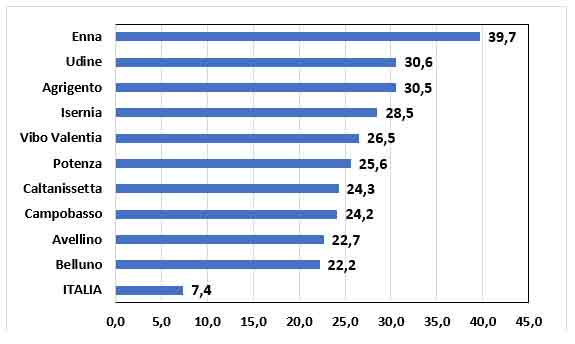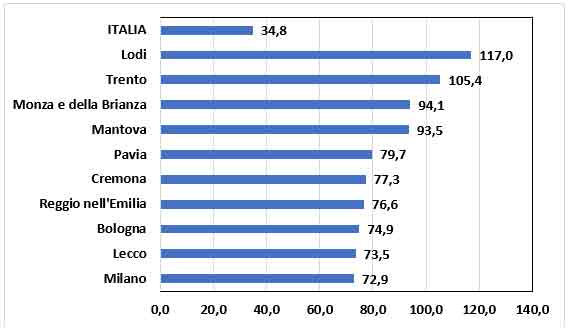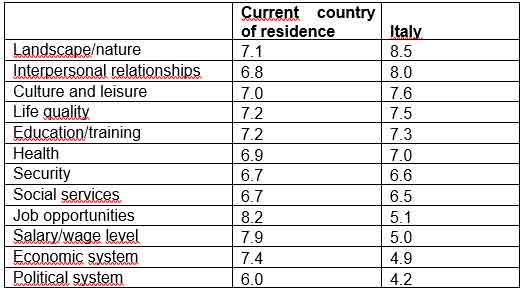A recent study carried out by the Laboratory for Local Economies (LEL – Laboratorio di Economia Locale) of Università Cattolica, thanks to the contribution of the Consulta degli Emiliano-Romagnoli nel mondo (Council of Emiliano-Romagnoli Abroad), analysed the migratory phenomenon out of Italy in recent years.
Through a reconstruction of the data on transfers abroad from Istat and AIRE (Registry of Italians Resident Abroad), a variegated picture of a phenomenon emerges, which at the end of the 19th century and in the first half of the 20th century recorded massive flows of emigration, especially from the marginal areas of the country. So much so that even today in some southern and Apennine municipalities, residents abroad are equal to almost 100% of the current resident population. This is the long-term outcome of historical flows, what is defined as the "old emigration", which has brought families and individuals to the new communities of London, Paris, New York, Buenos Aires, where lively aggregations remain and are still linked to their lands of origin.
But the new phenomenon highlighted by the report is also that of the "new emigration", which has very different characteristics, because it is represented above all by young people, always driven by the desire to find new life and work opportunities, not by poverty in their situations of origin. It is basically one of the many faces of globalization, which leads today's young people to enter the global labour market, in a dense and changing network of study and professional experiences, which determines sudden and multiplied transfers, sometimes without definitive roots. On the one hand we can undoubtedly recognize very positive and comforting experiences of success, entrepreneurship and career in the life stories of both the "old" and the "new" emigrants; on the other hand, it should be emphasized that the escape of about 1 million and 600 thousand people from Italy from 2002 to today (120 thousand from Emilia Romagna which was the focus of the research) also represents a "wound" for the territory, precisely because it is often considered as a loss of “precious” human capital, brilliant young people and talents who are not surprisingly appreciated in the rest of the world.
The survey on about 250 old and new emigrants (from Piacenza) also revealed their different perceptions of emigration, which always manifests the common traits of the emotional bond with the homeland, its traditions, food, music, sport, but also highlights differentiated judgments and feelings of "nostalgia". If the evaluation of the historical emigrants of the Bel Paese is very severe with respect to job opportunities, Italian wages and above all the economic and political system, among the young migrants only the Italian political framework appears to be deficient. This is to say that the "escape" from Italy does not seem to arise so much from situations of drastic economic and working difficulties, as from the desire to improve one's life, professional self-fulfilment, full satisfaction of one's aspirations. For both categories, however, the love for the country is confirmed, for its cultural and naturalistic resources, landscape heritage and again for the type of human and social relationships. If the reasons for work prevail today as in the past, the emotional reasons for reunification seem a push that is almost absent today, as well as the difficulties in learning the language, relevant obstacle in historical emigration.
The sense of territorial belonging also appears differentiated, due to the different number of years of "detachment" from the origin country, with the new emigrants who show a stronger attachment to their national roots. And despite this deep bond with their homeland, only a quarter of the emigrants would "return" home if they had the possibility, and this applies both to the descendants of historical emigrants, now integrated into the new realities of belonging, and to new emigrants, often fascinated by the vibrant strength of the new cities that have hosted them. The relationships with the communities of Italians abroad are also very different. These communities are active, consolidated associations, with frequent relations with the land of origin, in the case of old emigrants, but unwittingly closed to the new flows of globetrotter emigrants of our years.
Recent dynamics of Italian outbound migratory flows
The sources used to analyse outgoing migratory flows are the Registry of Italians Resident Abroad (AIRE), disclosed by the Ministry of Foreign Affairs, and Istat, through registrations/cancellations in the registry for the transfer of residence. The main difference in the data obtained from these two sources concerns the fact that the AIRE data are cumulated, i.e. each year of the survey presents the number of Italians enrolled in AIRE, while the Istat data represent those who transferred their residence abroad every year.
Starting from the analysis of the Italian Provinces according to the weight of AIRE members on the resident population and the variation of members in the last decade (between 2009 and 2018), it is possible to observe how the southern Regions are the main areas of departure, and in particular Molise with more than 25% of AIRE members over residents, followed by Basilicata and Calabria both close to 20%, followed in general by the other Regions of southern Italy, to highlight the cumulative largest flows, therefore the result of stories of emigration of at least the last century. As far as northern Italy is concerned, Friuli has 13% of AIRE over residents. It is clear that the Regions with less economic development hold the largest share of AIRE members over the population, which in the second half of the nineteenth century and the first half of the twentieth century experienced a real exodus of very significant dimensions. In particular, the Provinces of Enna (almost 40%), Agrigento, Vibo Valentia, Caltanissetta register the highest values, but the Provinces of Udine and Belluno also emerge, as a century ago these areas were among the poorest in the country (Fig.1).
Fig.1 The top 10 Italian Provinces by % weight of emigrants (AIRE members) over residents (2018 values)

Source: AIRE, LEL elaborations
However, if we analyse the % variation of AIRE members in the last decade (2009-2018) it is interesting to note how the situation changes: it is the northern Provinces that have shown greater dynamism in recent years, in particular Lodi, Trento, Monza, Mantua, Pavia, Cremona, Reggio Emilia (Fig.2): even from the most economically developed territories people moved abroad to improve their working conditions or to seek more qualified/specialized training offers. Another factor to consider is that this push occurs exactly with the advent of the Italian economic crisis which has not spared, or rather, has had a greater impact precisely on the most competitive local systems and therefore people have taken into consideration the hypothesis of emigrating abroad.
Fig.2 The top 10 Italian Provinces by % variation of emigrants (AIRE members) (2009-2018)

Source: AIRE, LEL elaborations
Then, analysing the Istat data on annual transfers abroad, the picture confirms the indications of the changes in AIRE members. The largest flows come from northern Provinces such as Bolzano, Imperia, Mantua, Gorizia, Vicenza and Trieste, with some areas of Central Italy such as Macerata and Teramo, all areas with values greater than 3 per 1,000 inhabitants per year.
Examining the variation of the absolute values in the last fifteen years, the previous trend is noted, i.e. it is the Provinces of the north that show greater dynamism with some of the centre. At the Italian level, the average is + 271.5%. Some Provinces have significant and high values: Viterbo went from 32 to 773 transfers per year over the period of time considered, Pavia from 77 to 1,584, Reggio Emilia from 111 to 1,643. That is, it emerges that the phenomenon of the new Italian emigration is much more linked to rich areas where young people look for new job and life opportunities, but not necessarily to "escape" from situations of economic or social hardship.
The comparison between Italy and the new country of residence
A sample survey was also carried out on a population of 215 Piacenza emigrants. The analysis of the answers aims in particular to highlight the similarities and inconsistencies between the experience of those who have emigrated to another country for more than 10 years and those with a more recent migration history. For this purpose, we use the term "old emigration" to identify the transfers prior to 1980, and the term "new emigration" for the transfers after 1980.
It is interesting to analyse how emigrants evaluate a series of dimensions related to the quality of life in Italy and abroad, aspects that also describe the degree of competitiveness of the different country systems. Out of 12 dimensions surveyed, the respondents seem to reward Italy compared to the current country of residence for about half of the proposed aspects. For the other half of the list, the conditions are considered much better (more efficient, fairer, more guaranteed) in the country of transfer. Overall, old and new generation emigrants reward Italy for landscape and nature (average rating of 8.5 on a scale of 1-10), quality of interpersonal relationships (8.0), cultural heritage and leisure opportunities (7.6), quality of life (7.5). The guarantees offered by public health and the level of the education and training systems in Italy are considered similar to those of the destination countries. Much more marked differences emerge in the comparison between job opportunities, salary level, economic system, political system. The evaluations attributed on average to Italy with respect to these dimensions are all insufficient and distant from the evaluations attributed to the foreign countries of residence.
Tab.1 Evaluation of current country of residence and Italy
(average values; scale 1-10)

The severity of the judgment of some aspects of the current Italian system in the labour market and in the political and economic fields seems to be attributable more to the old than to the new emigration. Young people, on average, generally seem more consistent between the assessments on the two countries (maximum absolute difference = 1.6) and although their assessments on the last four dimensions proposed are not rewarding for Italy, they are not as negative as the assessments attributed by the old generation of emigrants.




